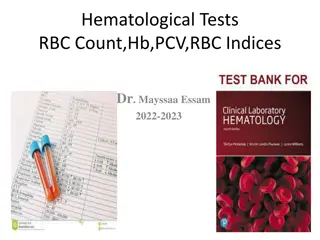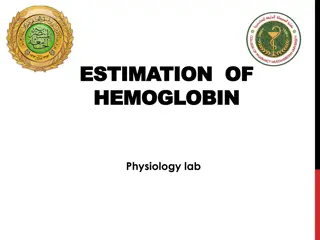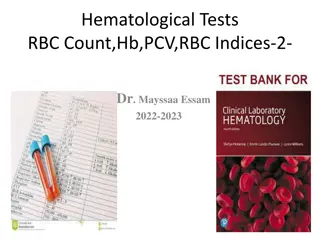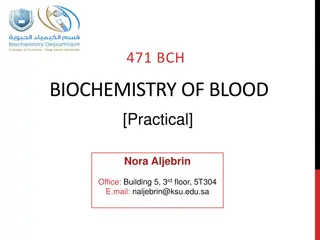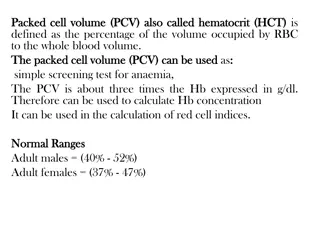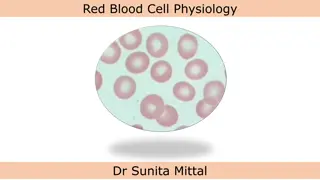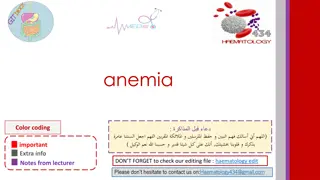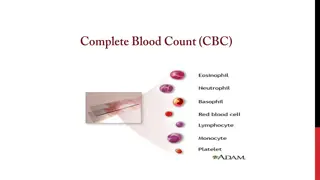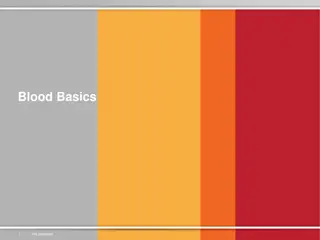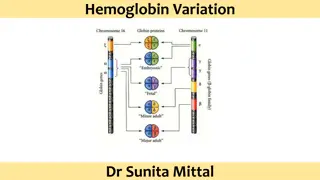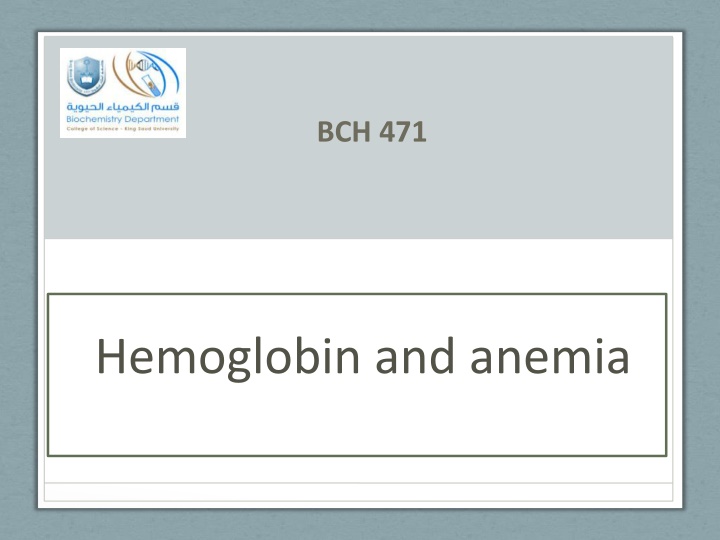
Quantitative Determination of Hemoglobin in Blood Samples
Hemoglobin (Hb) is a vital protein in red blood cells responsible for transporting oxygen and carbon dioxide throughout the body. Learn about the synthesis of Hb, its role in oxygen transport, and factors influencing Hb production and function like anoxia, erythropoietin, and essential vitamins and cofactors.
Download Presentation

Please find below an Image/Link to download the presentation.
The content on the website is provided AS IS for your information and personal use only. It may not be sold, licensed, or shared on other websites without obtaining consent from the author. If you encounter any issues during the download, it is possible that the publisher has removed the file from their server.
You are allowed to download the files provided on this website for personal or commercial use, subject to the condition that they are used lawfully. All files are the property of their respective owners.
The content on the website is provided AS IS for your information and personal use only. It may not be sold, licensed, or shared on other websites without obtaining consent from the author.
E N D
Presentation Transcript
BCH 471 Hemoglobin and anemia
Hemoglobin (Hb) is a porphyriniron (II) protien in RBCs that transport oxygen from the lungs to the rest of the body and carbon dioxide back to the lungs. Hb is made up of 4 subunits of globin protein , with a heam (iron containing group).
The circulation blood of normal adult contain about 750 g of Hb and of this about 7 8 g are degraded daily. This amount has to be newly synthesized each day. The rate of Hb synthesis (Rate of RBC formation) depends on The amount of oxygen reaching the blood Capacity of the blood to carry oxygen ,which in turn depend on the amount of circulating hemoglobin
Hb synthesis is stimulated by anoxia or hypoxia, whether due to oxygen deficiency or due to anaemia. Anoxia: means a total depletion in the level of oxygen, an extreme form of hypoxia or "low oxygen There is a strong evidence that the marrow response to the stimulus of hypoxia is dependent upon erythropoietin. Erythropoietin is a glycoprotein hormone formed in kidney in response to decrease oxygen carrying capacity (hypoxia or anoxia), in order to stimulate the erythropoiesis
Tissue hypoxia Kidney secrete erythropoietin into blood Return to homeostasis oxygen is delivered to kidney , this cause negative feedback inhibition to stop the secretion of erythropoietin when Increase erythropoiesis Increase number of RBC Increase oxygen carrying capacity
The role of some factor affecting on the native of haemoglobin: 1) Vitamins and cofactor: Biotin (B7), pantothenic acid (B5), folic acid (B9), coenzyme A and pyrodixal phosphate are essential for haem synthesis . 2) Trace metals : Only copper and cobalt are known to play a role . (Copper is playing a role in the absorption of iron while Cobalt is essential constituent of vitamine B12 (Cobalamin) ) 3) Glucose -6-phsphatase dehydrogenase (G6PD)
It is in general decrease in the amount of RBC or the normal amount of Hb in blood. It can also be defined as a lowered ability of the blood to carry oxygen. Causes: I. Genetics II. Acquired RBC membrane Defect Megaloblastic Anemia Iron-Deficiency Anemia
Iron-deficiency anemia: Deficiency of iron is essentially due to blood loss with failure to replace the iron stores because of : * Dietary deficiency or * Increase requirement or * Defective absorption. Megaloblastic Anemia: This may be due to deficiency of folic acid or cobaltamin (Vit. B12) RBC membrane defects: In this condition there is a defect of the erythrocyte membrane
Principle: The ferrouse (Iron II) in each haem in RBC is oxidized by ferricyanide to Fe(III)- methaemoglobin . A cynide group (CN-) is then attached to the iron atom (because it is positively charge) by reaction with KCN to give the brown cyanomethamoglobin (stable) which can be estimated quantitatively Normal Hb conc.: for men: 14 - 18 g/dl, for women : 12 - 16 g\dl Level of Hb is associated with polycythemia and dehydration Level of Hb is associated with aneamia
Pipette into clean dry test tubes Test Blank Hemoglobin reagent 2 ml 2 ml Blood sample 0.01 ml ( 10 l) _____ Mix, allow to stand at room temperature for 3 min and read the absorbance at 540 nm against hemoglobin reagent Hb conc (g/dl) = 29.4 x Abs of test
Quantitative Determination of G6PD Deficiency in Hemolysed RBC sample Objectives: Quantitative determination of glucose 6-phosphate dehydrogenase (G6PD) activity in erythrocytes (hemolysate).
Introduction G6PD deficiency is an inherited trait that predisposes to hemolytic anemia with jaundice.
RBCs are constantly challenged by oxidants (free radicals) generated by the conversion of oxyhaemoglobin to deoxyhaemoglobin and by peroxides generated by phagocytosing granulocytes. G6PD is an enzyme required to protect cells from damage by oxidation. It is responsible for the conversion glucose in the pentose phosphate pathway (PPP) to form 6-phosphogluconate , this pathway provide NADPH which is used to produce reduced glutathione (GSH). GSH is necessary for cell integrity by neutralizing free radicals that cause oxidative damage.
Normal RBCs can increase generation of NADPH in response to oxidative stress; this capacity is impaired in patients with G6PD deficiency. Failure to withstand oxidative stress due to G6PD deficiency, leads to decreased level of NADPH ,therefor Hb is oxidized by free radicals to met-Hb, which aggregates together causing hemolysis. Oxidative stress can result from infection and from chemical exposure to medication e.g. antimalarial drug, and certain foods e.g., fava beans
Principle Erythrocytes are lysed (by saponin) and their content is released Glucose + NADP+ G6PD 6-Phosphogluconate + NADPH + H+ The rate of formation of NADPH is a measure of the G6PDH activity and it can be followed by means of the increase in the Absorbance at 340 nm. Note: A red cell hemolysate is used to assay for deficiency of the enzyme, while serum is used for evaluation of enzyme elevations.
Method of G6PDH Pipette into clean and dry test tubes Reagent G6PDH Buffer NADP reagent Sample Volume 3 ml 100 l 50 l Mix and incubate for 5 min at 25 C, the add G6PDH Substrate 50 l Mix and read absorbance every min for 3 min against distilled water and calculate A/min
Results A/min=[(A3-A2)+(A2-A1)]/2 Time Abs 340 nm A1 1 min A2 2 min A3 3 min
Calculations G6PD Activity in mU/erythrocytes/ml of blood ( P )= A/min x 30868 Note: If the erythrocytes count per ml of blood is 5 X 109 Then the G6PD activity in mU/ 109cells = P/5
Qualitative determination of hemoglobin S (HbS) in blood. Objectives: Qualitative determination of hemoglobin S (HbS) in blood using a phosphate solubility method.
Introduction There are hundreds of Hb variants, and the most common are: Hemoglobin A It is normal hemoglobin that exists after birth and consist of ( 2 2). In normal adult 95% of Hb is present as HbA Hemoglobin A2 It is a minor component of the hemoglobin found in red cells after birth and consists of ( 2 2) less than 3% of the total red cell hemoglobin. Hemoglobin F Hemoglobin F is the predominant hemoglobin during fetal development and consists of ( 2 2).
Example of an abnormal Hb Hemoglobin S (HbS) The alpha chain is normal, while the beta chain is mutated, giving the molecule the structure, 2 S2. A point mutation in the Hb gene is responsible for the sickling of RBCs seen in sickle cell anemia .
Individuals with HbS will be at high risk when exposed to conditions of low oxygen tension such as surgery, high altitude or athletics which may results in serious and fatal clinical complications.
Principle Erythrocytes are lysed (by saponin) and the released hemoglobin is reduced (by dithionite) in phosphate buffer. Reduced HbS is characterized by its very low solubility So that in the presence of HbS, the solution become turbid and the lines behind the test tube will not be visible while, if no HbS was present the clear solution will permit the lines to be seen through the test tubes.
Method of HbS Pipette into clean dry test tube Reagent Sickling solution Patient sample (whole blood) Volume 2 ml 0.02 ml (20 l) Mix by inversion and allow stand at room temperature for 5 to 10 min Read the test by holding the test tube approximately 3 cm in front of a lined scale on the card.
Results _ +


